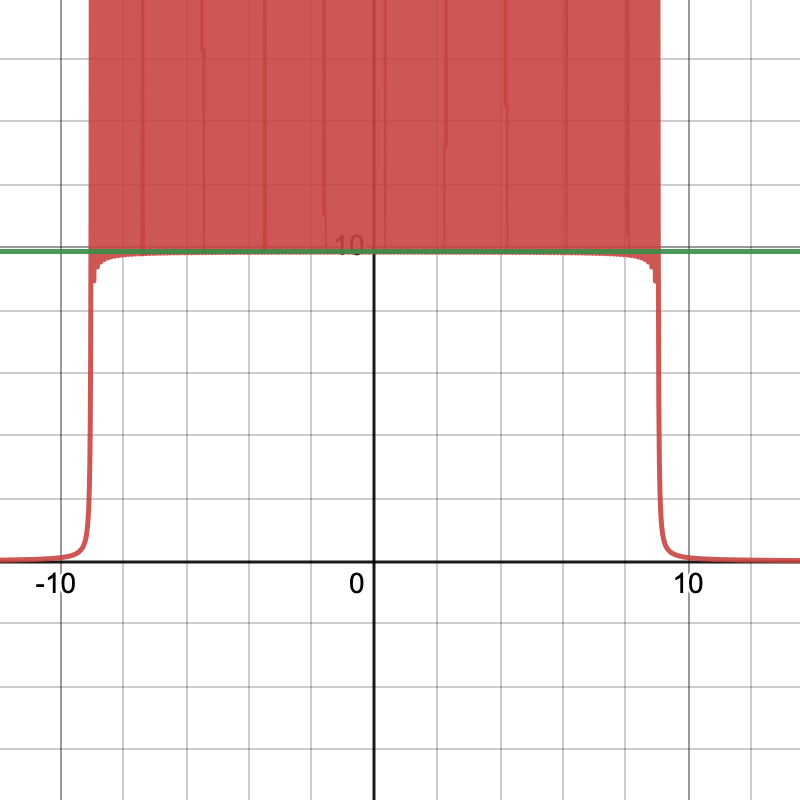$\newcommand{\ts}{\tilde s}$Yes, this is true.
Indeed, take any real $c\ge1/2$ and let
\begin{equation}
s_n(y):=\sum_{-n^2\le k\le n^2}\frac1{(ny-k)^2}
\end{equation}
and
\begin{equation}
\ts_n(x):=\inf_{|y-x|<c/n}s_n(y).
\end{equation}
Proposition 1: $\ts_n(x)\to\pi^2$ (as $n\to\infty$) uniformly over all real $x$ such that $n^2-n|x|\to\infty$.
The condition $n^2-n|x|\to\infty$ can be rewritten as $|x|\le n-\dfrac{\rho_n}n$ for some $\rho_n$ going (however slowly) to $\infty$. (This seems to be in agreement with your pictures.)
Proof of Proposition 1: Suppose that $n$ is large enough so that $n^2-n|x|>c+1$. Take any real $y$ such that $|y-x|<c/n$, so that $n|y|<n^2-1$. If $n|y|$ is an integer, then $s_n(y)=\infty$, so that excluding such values of $y$ does not affect the value of $\ts_n(x)$. Now, excluding such values of $y$ indeed and letting
\begin{equation}
m:=\lfloor ny\rfloor,
\end{equation}
we get
\begin{equation}
s_n(y)=s_{n,m}(u):=\sum_{-n^2+m\le j\le n^2+m}\frac1{(u+j+1/2)^2},
\end{equation}
where
\begin{equation}
u:=ny-(m+1/2)\in(-1/2,1/2).
\end{equation}
For $q=1,2,\dots,\infty$, let
\begin{equation}
t_q(u):=\sum_{-q-1< j<q}\frac1{(u+j+1/2)^2}.
\end{equation}
Then $t_q$ is an even convex function on the interval $(-1/2,1/2)$, so that
\begin{equation}
t_q\ge t_q(0)
\end{equation}
and, moreover,
\begin{equation}
t_\infty(0)=\pi^2.
\end{equation}
Furthermore, by the convexity of $\frac1{z^2}$ in $z>0$,
\begin{equation}
\pi^2-t_q(0)=t_\infty(0)-t_q(0)=2\sum_{j\ge q}\frac1{(j+1/2)^2}
<2\int_q^\infty\frac{dz}{z^2}=\frac2q.
\end{equation}
So, for $y$ as described above,
\begin{equation}
s_n(y)=s_{n,m}(u)\ge t_{n^2-|m|}(u)\ge t_{n^2-|m|}(0)
>\pi^2-\frac2{n^2-|m|}\to\pi^2,
\end{equation}
since $n^2-n|x|\to\infty$, $|m|\le n|y|+1$, and $|y-x|<c/n$, so that $n^2-|m|\ge n^2-n|x|-(c+1)\to\infty$, so that
\begin{equation}
\ts_n(x)=\inf_{|y-x|<c/n}s_n(y)\ge \pi^2-o(1).
\end{equation}
On the other hand, letting $l:=\lfloor nx\rfloor$, we have $|\frac{l+1/2}n-x|\le\frac1{2n}\le\frac cn$, so that
\begin{equation}
\ts_n(x)=\inf_{|y-x|<c/n}s_n(y)\le s_n\Big(\frac{l+1/2}n\Big)
=s_{n,l}(0)<t_\infty(0)=\pi^2.
\end{equation}
Proposition 1 follows immediately from the latter two displays. $\quad\Box$
 ,
,

